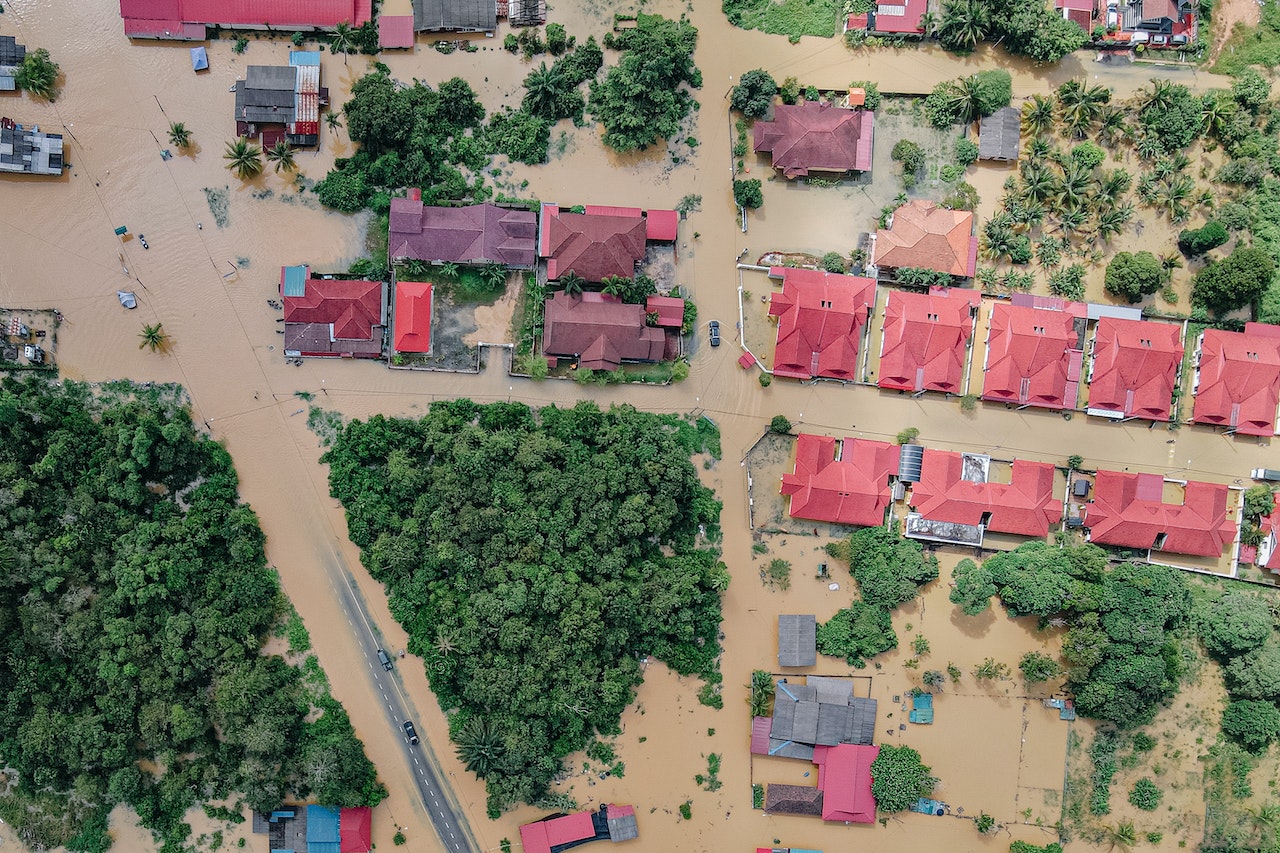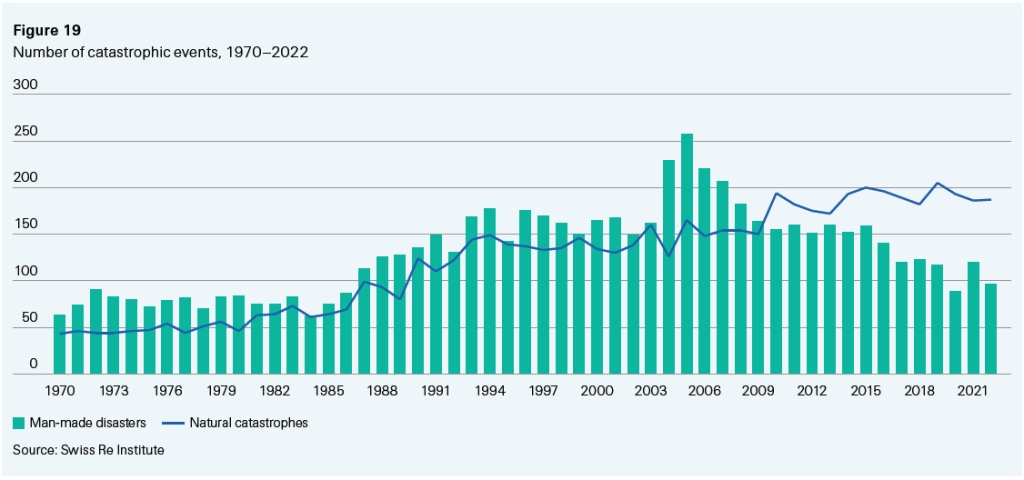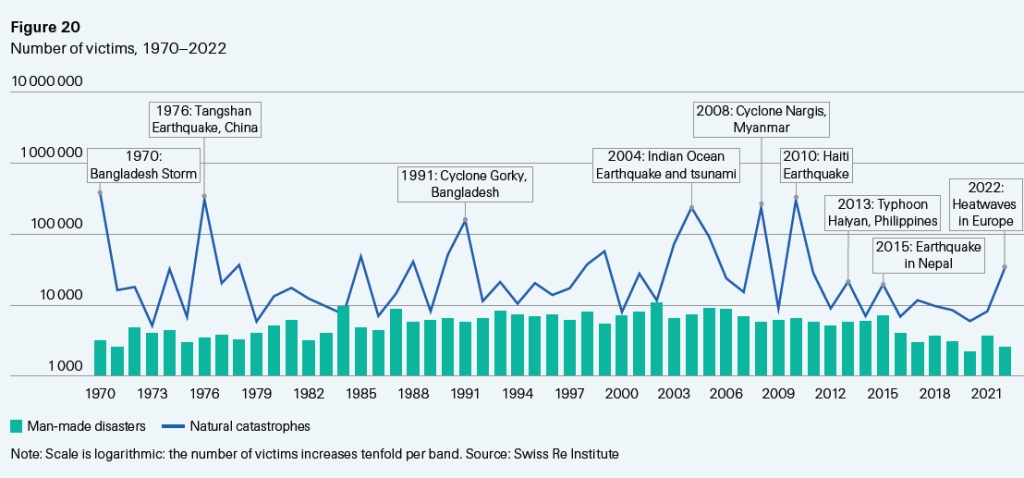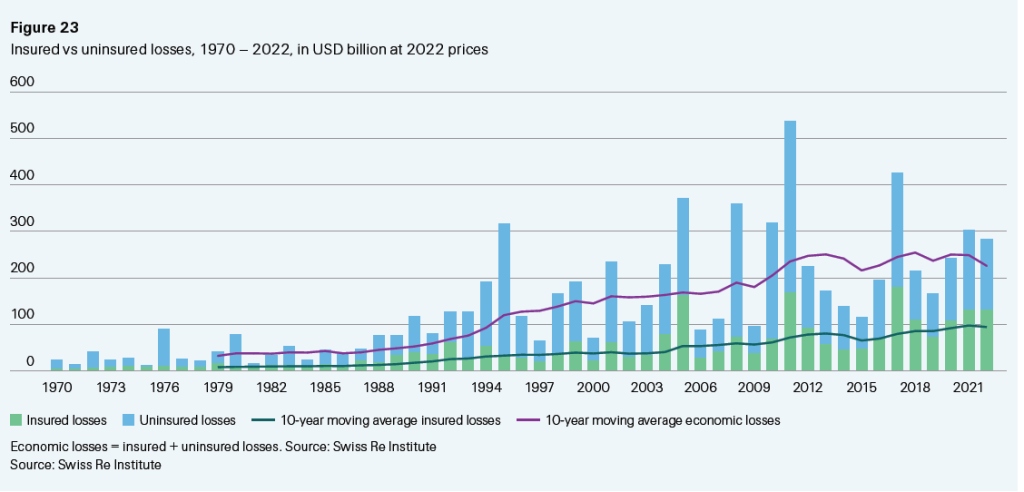Comments
- No comments found

Each year, the Swiss Re Institute has been publishing an annual report on the natural catastrophes of the previous year, of particular interest to specialists, and some long-run trendlines, which are more interesting to me. This year’s report is “Natural catastrophes and inflation in 2022: a perfect storm” (Sigma, 2023, No. 1).
Here’s the number of catastrophes around the world. in the last half-century. Natural catastrophes include “floods, storms, earthquakes, droughts/forest fires/heat waves, cold waves/frost, hail, tsunamis, and other natural catastrophes.” Man-made catastrophes do not include war, but instead are divided into the categories of “major fires and explosions, aviation and space disasters, shipping disasters, rail disasters, mining accidents, collapse of buildings/bridges, and miscellaneous (including terrorism).”

It’s wise to interpret these numbers with care. After all, the global population has more than doubled since 1970, which more-or-less fits the rise up to the early 2000s, although it doesn’t explain the spike in the mid-2000s or the more recent decline (which precedes the pandemic). Also, if a natural event that would be a catastrophe if it happens in a heavily populated area occurs instead in a lightly populated area, does it count as a catastrophe of the same scale? The world’s apparatus for discovering and reporting natural catastrophes was clearly less developed a half-century ago. That said, it appears that man-made disasters have been declining in the last decade or so, while natural catastrophes have been trending up over time.
What about the costs? Let’s look first at lives lost. Notice that the vertical scale is logarithmic, not arithmetic (that is, it rises by factors of ten). The report notes: “Worldwide, 35 157 people are believed to have died or gone missing in disaster events in 2022. Natural catastrophes claimed over 32 600 victims, and man-made disasters over 2500.”

Here, the general pattern seems to be that deaths from man-made disasters are both an order of magnitude lower than natural disasters, and also declining. There doesn’t seem to be any particular trend to deaths from natural disasters, just a pattern of big spikes when an especially awful disaster occurs somewhere.
Finally, here’s an estimate of the total financial costs of these disasters, and because Swiss Re is a reinsurance company, the share of those costs is covered by insurance. These costs are adjusted for inflation. The sharp rise is because of economic growth and rising property values: for example, a hurricane hitting Florida now will have a higher financial cost than the same hurricane hitting in 1970.

It’s also worth remembering that financial costs will depend on local prices, such that financial costs will be higher in high-income, high-price countries. The report notes that the gap between insured financial losses and total financial losses seems to be rising: it was 53% in 2022, down from 59% over the average of the last ten years.
Timothy Taylor is an American economist. He is managing editor of the Journal of Economic Perspectives, a quarterly academic journal produced at Macalester College and published by the American Economic Association. Taylor received his Bachelor of Arts degree from Haverford College and a master's degree in economics from Stanford University. At Stanford, he was winner of the award for excellent teaching in a large class (more than 30 students) given by the Associated Students of Stanford University. At Minnesota, he was named a Distinguished Lecturer by the Department of Economics and voted Teacher of the Year by the master's degree students at the Hubert H. Humphrey Institute of Public Affairs. Taylor has been a guest speaker for groups of teachers of high school economics, visiting diplomats from eastern Europe, talk-radio shows, and community groups. From 1989 to 1997, Professor Taylor wrote an economics opinion column for the San Jose Mercury-News. He has published multiple lectures on economics through The Teaching Company. With Rudolph Penner and Isabel Sawhill, he is co-author of Updating America's Social Contract (2000), whose first chapter provided an early radical centrist perspective, "An Agenda for the Radical Middle". Taylor is also the author of The Instant Economist: Everything You Need to Know About How the Economy Works, published by the Penguin Group in 2012. The fourth edition of Taylor's Principles of Economics textbook was published by Textbook Media in 2017.
Leave your comments
Post comment as a guest